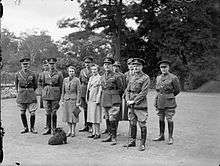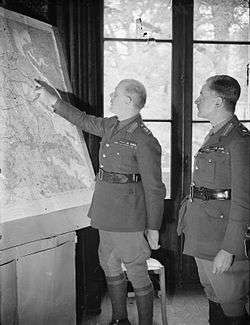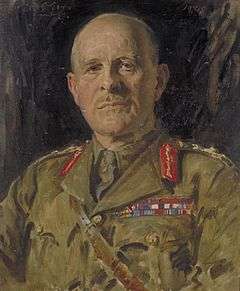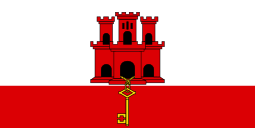John Vereker, 6th Viscount Gort
Field Marshal John Standish Surtees Prendergast Vereker, 6th Viscount Gort, VC, GCB, CBE, DSO & Two Bars, MVO, MC (10 July 1886 – 31 March 1946) was a senior British Army officer. As a young officer during the First World War he was decorated with the Victoria Cross for his actions during the Battle of the Canal du Nord. During the 1930s he served as Chief of the Imperial General Staff (the professional head of the British Army). He is most famous for commanding the British Expeditionary Force sent to France in the first year of the Second World War, which was evacuated from Dunkirk. Gort later served as Governor of Gibraltar and Malta, and High Commissioner for Palestine and Transjordan.
Early life and family
John Standish Surtees Prendergast Vereker was born in London. His mother was Eleanor, Viscountess Gort née Surtees (1846–1933; later Eleanor Benson),[1] who was a daughter of writer Robert Smith Surtees. J. S. S. P. Vereker's father was John Gage Prendergast Vereker, 5th Viscount Gort (1849 –1902).[1]
The title of Viscount Gort, which J. S. S. P. Vereker inherited upon the death of his father, was named after Gort, a town in the West of Ireland and the Prendergast Vereker family were members of the Anglo-Irish nobility. His father was also a descendant of figures prominent in the British American colonies, including Thomas Gage and Margaret Kemble, as well as the Schuyler, Van Cortlandt, and Delancey families.[2]
J. S. S. P. Vereker grew up in County Durham and the Isle of Wight. He was educated at Malvern Link Preparatory School, Harrow School, and entered the Royal Military Academy, Woolwich in January 1904. As Viscount Gort, he was commissioned as a second lieutenant in the Grenadier Guards on 16 August 1905,[3] and promoted to lieutenant on 1 April 1907.[3]
In November 1908, Gort visited his uncle, Jeffrey Edward Prendergast Vereker, a retired British army major, who was living in Canada, at Kenora, Ontario. During a moose hunting trip, Gort slipped off a large boulder, causing his rifle to discharge; the bullet injured a local guide, William Prettie, who later died of his wound in Winnipeg. Gort returned immediately to England.[4]
Gort commanded the detachment of Grenadier Guards that bore the coffin at the funeral of King Edward VII in May 1910.[3] He was made a Member of the Royal Victorian Order for his services in that role.[5]
On 22 February 1911, Gort married Corinna Katherine Vereker, his second cousin; the couple had two sons and a daughter,[3] before divorcing (1925).[6] Their eldest son, Charles Standish Vereker, was born on 23 February 1912, and served as a lieutenant with the Grenadier Guards, before committing suicide (26 February 1941).[7][8][9] A second son, Jocelyn Cecil Vereker, was born on 27 July 1913, but died before his second birthday.[10] Gort's daughter, Jacqueline Corinne Yvonne Vereker, who was born on 20 October 1914, married (June 1940) The Honourable William Sidney, later the 1st Viscount De L'Isle.[11]
First World War
On 5 August 1914, Gort was promoted to captain.[12] He went to France with the British Expeditionary Force and fought on the Western Front, taking part in the retreat from Mons in August 1914.[13] He became a staff officer with the First Army in December 1914 and then became Brigade Major of the 4th (Guards) Brigade in April 1915.[13] He was awarded the Military Cross in June 1915.[14] Promoted to the brevet rank of major in June 1916, he became a staff officer at the Headquarters of the British Expeditionary Force and fought at the Battle of the Somme throughout the autumn of 1916.[13] He was given the acting rank of lieutenant colonel in April 1917[15] on appointment as Commanding Officer of 4th Battalion Grenadier Guards and, having been awarded the Distinguished Service Order (DSO) in June 1917,[16] he led his battalion at the Battle of Passchendaele,[13] earning a Bar to his DSO in September 1917.[17][18]
On 27 November 1918, Gort was awarded the Victoria Cross, the highest award for gallantry in the face of the enemy that can be awarded to British and Commonwealth forces, for his actions on 27 September 1918 at the Battle of the Canal du Nord, near Flesquieres, France.[19]
Victoria Cross citation
Captain (Brevet Major, Acting Lieutenant-Colonel), 1st Battalion The Grenadier Guards
Citation: For most conspicuous bravery, skilful leading and devotion to duty during the attack of the Guards Division on 27th September 1918, across the Canal du Nord, near Flesquieres, when in command of the 1st Battalion, Grenadier Guards, the leading battalion of the 3rd Guards Brigade. Under heavy artillery and machine-gun fire he led his battalion with great skill and determination to the "forming-up" ground, where very severe fire from artillery and machine guns was again encountered. Although wounded, he quickly grasped the situation, directed a platoon to proceed down a sunken road to make a flanking attack, and, under terrific fire, went across open ground to obtain the assistance of a Tank, which he personally led and directed to the best possible advantage. While thus fearlessly exposing himself, he was again severely wounded by a shell. Notwithstanding considerable loss of blood, after lying on a stretcher for awhile [sic], he insisted on getting up and personally directing the further attack. By his magnificent example of devotion to duty and utter disregard of personal safety all ranks were inspired to exert themselves to the utmost, and the attack resulted in the capture of over 200 prisoners, two batteries of field guns and numerous machine guns. Lt.-Col. Viscount Gort then proceeded to organise the defence of the captured position until he collapsed; even then he refused to leave the field until he had seen the "success signal" go up on the final objective. The successful advance of the battalion was mainly due to the valour, devotion and leadership of this very gallant officer.[19]
Subsequent to this he became known as "Tiger" Gort.[20] He won a second Bar to his DSO in January 1919.[21] He was also mentioned in despatches eight times during the war.[13]
Inter-war years
Gort was promoted to the substantive rank of major on 21 October 1919.[22] After attending a short course at the Staff College, Camberley, in 1919 he joined Headquarters London District and, having been promoted to brevet lieutenant colonel on 1 January 1921,[23] he returned to the College as an instructor.[13] He left the Staff College in May 1923.[24]
Gort was promoted to colonel in April 1926 (with seniority backdated to 1 January 1925).[25] In 1926 he became a staff officer at London District before becoming a chief instructor at the Senior Officers' School at Sheerness.[6] In January 1927, he went to Shanghai, returning in August to give a first hand account of the Chinese situation to the King and the Prince of Wales. He returned home to be a staff officer at Headquarters 4th Infantry Division at Colchester in July 1927.[6]
In June 1928, Gort was appointed a Commander of the Order of the British Empire.[26] He went on to command the Guards Brigade for two years from 1930 before overseeing training in India with the temporary rank of brigadier.[27] In 1932, he took up flying, buying the de Haviland Moth aircraft Henrietta and being elected chairman of the Household Brigade Flying Club. On 25 November 1935, he was promoted to major general.[28] He returned to the Staff College, Camberley in 1936 as Commandant.[6]
In May 1937, Gort was appointed a Companion of the Order of the Bath.[29] In September 1937, he became Military Secretary to the War Minister, Leslie Hore-Belisha, with the temporary rank of lieutenant general.[30] On 6 December 1937, as part of a purge by Hore-Belisha of senior officers,[31] Gort was appointed to the Army Council,[32] made a general and replaced Field Marshal Sir Cyril Deverell as Chief of the Imperial General Staff.[33] On 1 January 1938, he was made a Knight Commander of the Order of the Bath.[34]
As Chief of the Imperial General Staff, Gort advocated the primacy of building a land army and defending France and the Low Countries over Imperial defence after France had said she would not be able on her own to defend herself against a German attack.[35]
On 2 December 1938 Gort submitted a report on the readiness of the British Army. He observed that Germany, as a result of the acquisition of Czechoslovakia, was in a stronger position than the previous year and that as a result of the government's decision in 1937 to create a "general purpose" army, Britain lacked the necessary forces for the defence of France.[36]
On 21 December Gort recommended to the Chiefs of Staff that Britain would need to help France defend Holland and Belgium and that for that purpose the British Army needed complete equipment for four Regular army infantry divisions and two mobile armoured divisions, with the Territorial army armed with training equipment and then war equipment for four divisions.[37] The First Sea Lord, Admiral Sir Roger Backhouse, replied that Britain's continental commitment might not be a limited liability. Gort replied: "Lord Kitchener had clearly pointed out that no great country can wage a “little” war". He also attacked as a fallacy the theory of strategic mobility by the use of seapower because in modern war land transport was faster and cheaper than transport by sea. The experience of David Lloyd George's 1917 Alexandretta project "proved that [maritime side-shows] invariably led to vast commitments out of all proportion to the value of the object attained".[38] If a purely defensive position was taken the Maginot Line would be broken and that the British Army (with anti-aircraft defence) was only getting £277 million out of a total £2,000 million spent on defence.[39]
Second World War

At the outbreak of the Second World War Gort was given command of the British Expeditionary Force (BEF) in France, arriving on 19 September 1939.[40] During this time he played a part in a political manoeuvre, the Pillbox affair, that led to the dismissal of War Minister Leslie Hore-Belisha. Unimpressed by his qualities for command, Hore-Belisha described him as utterly brainless and unable to grasp the simplest problem.[41] Following the Phoney War, the 1940 German breakthrough in the Ardennes split the Allied forces and communications between the BEF and the French broke down, and on 25 May 1940 Gort took the unilateral decision to abandon his orders for a southward attack by his forces.[42] Gort's command position was difficult, serving under French high theatre and army group command, while also being responsible to London. Withdrawing northwards, most of the BEF, together with many French and Belgian soldiers, were evacuated during the Battle of Dunkirk and the evacuation to England.[43]
Gort is credited by some as reacting efficiently to the crisis and saving the BEF.[42] Others hold a more critical view of Gort’s leadership in 1940, seeing his decision not to join the French in organising a large scale counter-attack as defeatist.[44]
Gort served in various positions for the duration of the war. On the day of his return, 1 June 1940, he was made an ADC General to King George VI. On 25 June 1940 he went by flying boat, with Duff Cooper, to Rabat, Morocco, to rally anti-Nazi French cabinet ministers, but was instead held on his flying boat. He quickly returned to Britain.[45]

Gort was given the post of Inspector of Training and the Home Guard,[40] and with nothing constructive to do visited Iceland, Orkney and Shetland. He went on to serve as Governor of Gibraltar (1941–42).[46] In 1943 he succeeded Lord Galway as Colonel Commandant of the Honourable Artillery Company, a position he held until his death.[47]
As Governor of Malta (1942–44) Gort's courage and leadership during the siege was recognised by the Maltese giving him the Sword of Honour. He pushed ahead with extending the airfield into land reclaimed from the sea, against the advice of the British government, but was later thanked by the War Cabinet for his foresight when the airfield proved vital to the British Mediterranean campaign. The King gave Gort his field marshal's baton on 20 June 1943 at Malta. On 29 September, Gort, together with Generals Eisenhower and Alexander, witnessed Marshal Badoglio signing the Italian surrender in Valletta harbour.[48]
Gort was present when his son-in-law, Major William Sidney, received the Victoria Cross from General Sir Harold Alexander, Commander-in-Chief (C-in-C) of the Allied Armies in Italy (AAI), on 3 March 1944 in Italy.[46]
Gort ended the war as High Commissioner for Palestine and Transjordan.[46] He served at this office only one year. In 1945 he nominated William James Fitzgerald, Chief Justice of Palestine, to enquire into the Jewish-Arab conflict in Jerusalem. Chief Justice Fitzgerald issued his report in which he proposed to divide the city into separate Jewish and Arab Quarters.[49] Despite growing tensions in Palestine, Gort strove to cultivate good personal relations with both Jews and Arabs, and was greatly admired and respected by the Jewish and Arab communities.[50]
During his time in Palestine, Gort's health deteriorated, and he was suffering from great pain and discomfort in his abdomen. He was in fact suffering from liver cancer, but the doctors he consulted in London were unable to properly diagnose his condition. Gort ruled Palestine at the time that the Jewish insurgency was beginning. Despite his efforts, he was unable to stem the growing confrontation between the Yishuv (Jewish community) and British authorities. On 5 November 1945, he stepped down as High Commissioner and returned to Britain. Commenting on his departure, The Palestine Post wrote that "No High Commissioner in the twenty-five years of British rule in Palestine enjoyed greater popular trust and none repaid it with greater personal kindness."[50]
Post-war period and death
After leaving Palestine, Gort was admitted to Guy's Hospital in London, where exploratory surgery revealed that he was dying from inoperable liver cancer.[46][50]
In February 1946, he was created a Viscount in the Peerage of the United Kingdom under the same title as his existing Viscountcy in the Peerage of Ireland. On 31 March 1946, Gort died in Guy's Hospital at age 59. As he did not have a surviving son, the Irish Viscountcy of Gort passed to his brother, and the British creation became extinct.[46] Gort is buried in the Sidney family vault at St John the Baptist, Penshurst.[46]
He was portrayed in the 1958 film Dunkirk by Cyril Raymond.[51]
References
- 1 2 "Eleanor Surtees". The Peerage. Retrieved 13 November 2017.
- ↑ "The Peerage: A genealogical survey of the peerage of Britain as well as the royal families of Europe". Retrieved 11 February 2015.
- 1 2 3 4 Heathcote 1999, p. 279.
- ↑ Stewart, Bob. "Kenora was once home to a peer of the realm". Kenora Daily Miner and News. Retrieved 1 April 2015.
- ↑ "No. 28384". The London Gazette. 14 June 1910. p. 4172.
- 1 2 3 4 Heathcote 1999, p. 281.
- ↑ Lundy, Darryl (30 April 2011). "Hon. Charles Standish Vereker". www.thepeerage.com. Retrieved 26 April 2014.
- ↑ "Lieut Charles Standish Vereker". www.findagrave.com. Retrieved 26 April 2014.
Birth 23 Feb 1912, Chelsea [...] Greater London, England Death 27 Feb 1941 Dorset, England Burial Corfe Mullen Cemetery Corfe Mullen, East Dorset District, Dorset, England Plot Sec. P. Grave 312. Memorial ID 106105435. [...] The Hon. Charles Vereker served in the Grenadier Guards Service No:121330. [...] He married Yvonne Frances Barnett, daughter of Major Geoffrey Arthur Barnett, on 21 April 1938. He died at age 29, without issue. He graduated from Trinity College, Cambridge University, with a Bachelor of Arts (B.A.).
- ↑ John Keegan, 1991, Churchill's Generals, London, Hachette, p. 49.
- ↑ Lundy, Darryl (30 April 2011). "Hon. Jocelyn Cecil Vereker". www.thepeerage.com. Retrieved 26 April 2014.
- ↑ Lundy, Darryl (30 April 2011). "Hon. Jacqueline Corinne Yvonne Vereker". www.thepeerage.com. Retrieved 26 April 2014.
- ↑ "No. 28884". The London Gazette (Supplement). 29 August 1914. p. 6880.
- 1 2 3 4 5 6 Heathcote 1999, p. 280.
- ↑ "No. 29202". The London Gazette (Supplement). 23 June 1915. p. 6118.
- ↑ "No. 30106". The London Gazette (Supplement). 1 June 1917. p. 5403.
- ↑ "No. 30111". The London Gazette (Supplement). 4 June 1917. pp. 5468–5470.
- ↑ "No. 30308". The London Gazette (Supplement). 26 September 1917. p. 9967.
- ↑ "No. 30466". The London Gazette (Supplement). 9 January 1918. pp. 557–558.
- 1 2 "No. 31034". The London Gazette (Supplement). 27 November 1918. p. 14039.
- ↑ "Tiger for Old Dob Dob". TIME. 18 May 1942. Retrieved 14 February 2009.
- ↑ "No. 31119". The London Gazette (Supplement). 11 January 1919. pp. 577–578.
- ↑ "No. 31643". The London Gazette (Supplement). 14 November 1919. p. 13876.
- ↑ "No. 32334". The London Gazette (Supplement). 25 May 1921. p. 4170.
- ↑ "No. 32819". The London Gazette. 1 May 1923. pp. 3147–3148.
- ↑ "No. 33155". The London Gazette. 27 April 1926. p. 2861.
- ↑ "No. 33390". The London Gazette (Supplement). 4 June 1928. p. 3851.
- ↑ "No. 33904". The London Gazette. 20 January 1933. p. 442.
- ↑ "No. 34226". The London Gazette. 3 December 1935. p. 7671.
- ↑ "No. 34396". The London Gazette (Supplement). 11 May 1937. pp. 3078–3079.
- ↑ "No. 34438". The London Gazette. 24 September 1937. p. 5957.
- ↑ "Belisha Purge". Time. 13 December 1937. Retrieved 14 February 2009.
- ↑ "No. 34464". The London Gazette. 17 December 1937. p. 7915.
- ↑ "No. 34464". The London Gazette. 17 December 1937. p. 7917.
- ↑ "No. 34469". The London Gazette (Supplement). 1 January 1938. p. 3.
- ↑ Falls 2009
- ↑ Barnett, p. 552.
- ↑ Barnett, p. 553.
- ↑ Barnett, pp. 553–554.
- ↑ Barnett, p. 554.
- 1 2 Heathcote 1999, p. 282.
- ↑ Dixon, Norman F, On The Psychology Of Military Incompetence, Pimlico, ISBN 9780712658898
- 1 2 Ellis 1954, p.149.
- ↑ Gardner 2000, p. 56.
- ↑ Moure & Alexander 2001, p. 24.
- ↑ "The Second World War in the French Overseas Empire". World at War. Retrieved 7 October 2012.
- 1 2 3 4 5 6 Heathcote 1999, p. 283.
- ↑ Johnson, p. 353-354
- ↑ Garland, p. 549
- ↑ "Sir W. FitzGerald report and a map illustrating the Jewish proposals for Jerusalem in 1945". Gilai Collectibles. Retrieved 7 October 2012.
- 1 2 3 Hoffman, Bruce: Anonymous Soldiers (2015)
- ↑ "Dunkirk (1958)". Screen on line. Retrieved 12 September 2016.
Sources
- Barnett, Corelli (2002). The Collapse of British Power. Pan. ISBN 978-0330491815.
- Ellis, Major L.F. (1954). The War in France and Flanders 1939–1940. History of the Second World War: United Kingdom Military. HMSO.
- Falls, Cyrl (2009). "Vereker, John Standish Surtees Prendergast, sixth Viscount Gort in the peerage of Ireland and first Viscount Gort in the peerage of the United Kingdom (1886–1946)". Oxford Dictionary of National Biography. Oxford University Press. doi:10.1093/ref:odnb/36642. Retrieved 14 February 2009.
- Gardner, W.J.R, ed. (2000) [First published 1949]. The Evacuation of Dunkirk: Operation Dynamo. Routledge. ISBN 978-0-7146-5120-0.
- Garland, Albert (1986). United States Army in World War 2, Mediterranean Theater of Operations, Sicily and the Surrender of Italy. United States Government Printing. ISBN 978-9990858822.
- Heathcote, Tony (1999). The British Field Marshals 1736–1997. Pen & Sword Books. ISBN 0-85052-696-5.
- Johnson, Brigadier R.F. (1958). Regimental Fire, A History of the HAC in World War II 1939–1945.
- Moure, Kenneth; Alexander, Martin S. (2001). Crisis and Renewal in Twentieth Century France. Berghahn Books. ISBN 978-1-57181-297-1.
Further reading
- Buzzell, Nora, ed. (1997). The Register of the Victoria Cross. This England. ISBN 0-906324-27-0.
- Colville, J R (1972). Man of Valour. London: Collins. ISBN 0-00-211290-6.
- Danchev, Alex, and Todman, Daniel, ed. (2001) [First published 1957]. War Diaries 1939–1945 Field Marshal Lord Alanbrooke. University of California Press. ISBN 0-520-23301-8.
- Gliddon, Gerald (2000). VCs of the First World War - The Final Days 1918. Sutton Publishing. ISBN 0-7509-2485-3.
- Harvey, David (1999). Monuments to Courage : Victoria Cross Headstones and Memorials. Vol.2, 1917–1982. Kevin & Kay Patience. OCLC 59437300.
External links
| Wikimedia Commons has media related to John Vereker, 6th Viscount Gort. |
- British Army Officers 1939−1945
- Hansard 1803–2005: contributions in Parliament by the Viscount Gort
- Location of grave and VC medal (Kent)
- Memorial to Lord Gort in the Sidney Chapel at St John the Baptist, Penshurst
- Generals of World War II
- Newspaper clippings about John Vereker, 6th Viscount Gort in the 20th Century Press Archives of the German National Library of Economics (ZBW)
| Military offices | ||
|---|---|---|
| Preceded by Clement Armitage |
Commandant of the Staff College, Camberley 1936–1937 |
Succeeded by Ronald Adam |
| Preceded by Sir Charles Deedes |
Military Secretary September–December 1937 |
Succeeded by Sir Douglas Brownrigg |
| Preceded by Sir Cyril Deverell |
Chief of the Imperial General Staff 1937–1939 |
Succeeded by Sir Edmund Ironside |
| Government offices | ||
| Preceded by Sir Clive Liddell |
Governor of Gibraltar 1941–1942 |
Succeeded by Sir Noel Mason-Macfarlane |
| Preceded by Sir William Dobbie |
Governor of Malta 1942–1944 |
Succeeded by Sir Edmond Schreiber |
| Preceded by Sir Harold MacMichael |
High Commissioner for Palestine and High Commissioner for Trans-Jordan 1944–1945 |
Succeeded by Sir Alan G. Cunningham |
| Peerage of the United Kingdom | ||
| New creation | Viscount Gort 2nd creation 1945–1946 |
Extinct |
| Peerage of Ireland | ||
| Preceded by John Vereker |
Viscount Gort 1st creation 1902–1946 |
Succeeded by Standish Vereker |


